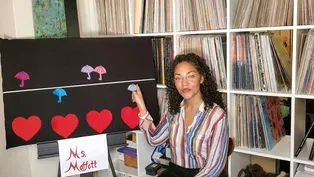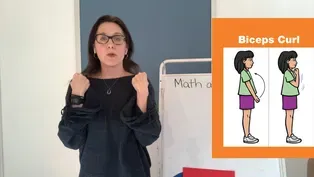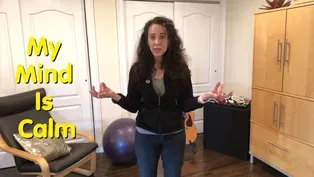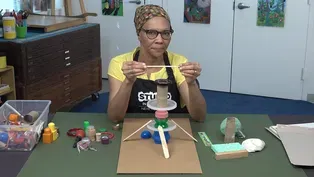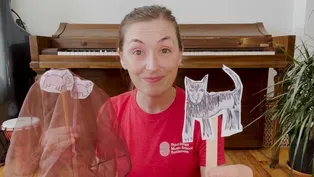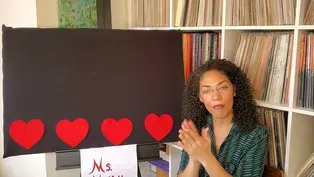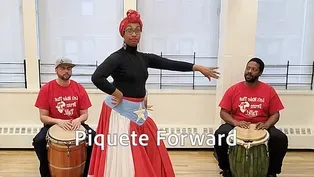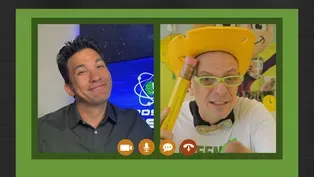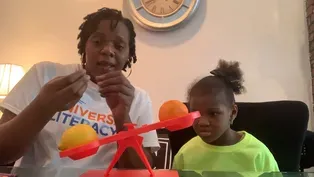
What Sounds Do You Hear in Question?
2/10/2021 | 55m 14sVideo has Closed Captions
Learn about number bonds and what makes you unique, read LLAMA DESTROYS THE WORLD.
Learn about number bonds and what makes you unique, read LLAMA DESTROYS THE WORLD, blend and practice short e, qu, x, and z. LET’S LEARN helps children ages 3-8 with at-home learning. One-hour programs feature instruction by educators and virtual field trips.
Problems with Closed Captions? Closed Captioning Feedback
Problems with Closed Captions? Closed Captioning Feedback
Let's Learn is a local public television program presented by THIRTEEN PBS

What Sounds Do You Hear in Question?
2/10/2021 | 55m 14sVideo has Closed Captions
Learn about number bonds and what makes you unique, read LLAMA DESTROYS THE WORLD, blend and practice short e, qu, x, and z. LET’S LEARN helps children ages 3-8 with at-home learning. One-hour programs feature instruction by educators and virtual field trips.
Problems with Closed Captions? Closed Captioning Feedback
How to Watch Let's Learn
Let's Learn is available to stream on pbs.org and the free PBS App, available on iPhone, Apple TV, Android TV, Android smartphones, Amazon Fire TV, Amazon Fire Tablet, Roku, Samsung Smart TV, and Vizio.
Providing Support for PBS.org
Learn Moreabout PBS online sponsorshipMore from This Collection
Video has Closed Captions
Read SCHOOL BUS and draw one, learn about prefixes and pitch, build sculptures. (57m 48s)
Running and Counting Both End in “ing”!
Video has Closed Captions
Move to improve, find the missing number, learn songs from Ghana, read ABUELITA’S SECRET. (58m 17s)
What Sound Does “aw” Make in Draw?
Video has Closed Captions
Read a story, discover "au" and "aw," learn about density, count, and move with music. (56m 58s)
Can You Find the Short “u” in Subtract?
Video has Closed Captions
Help Super Grover 2.0 solve a prickly problem, read ALL THE WAYS TO BE SMART. (56m 19s)
What Sound Does “gl” Make in Glove?
Video has Closed Captions
Play the glockenspiel, help Super Grover 2.0 make a cart move, read TWO WOOL GLOVES. (58m 9s)
Incredible Starts with Short “i”!
Video has Closed Captions
Solve problems with Super Grover 2.0, catch a rainbow, hear a piano sound like a cuckoo. (56m 9s)
What’s the Sound of “oo” in Book?
Video has Closed Captions
Explore animals’ form and function, sing about the 3 little pigs, read THE LITTLE BOX. (58m 15s)
We’re Reducing, Reusing and Recycling!
Video has Closed Captions
Learn all about rhythm and the number 9, read A BAG IN THE WIND. (56m 17s)
Video has Closed Captions
Learn to dance bomba and grow food in a city, read WOLF CUB’S SONG. (55m 20s)
How Many Syllables are in Invent?
Video has Closed Captions
Invent your own instrument, make 10 to add numbers to 20, read ONE GOLDEN RULE AT SCHOOL. (57m 36s)
Video has Closed Captions
Learn about the science behind mind reading, count shells, read MY BIG FAMILY. (57m 27s)
Which is Heavier: One Apple or Two Apples?
Video has Closed Captions
Defy gravity, learn secret code words for fast and slow in music, read WHOOO KNEW? (58m 5s)
Providing Support for PBS.org
Learn Moreabout PBS online sponsorship- [Spokeswoman] Ready to learn?
- [Both] Hi!
- [Spokeswoman] It's time to share a story, read and write.
- Let's read it back.
- [Spokeswoman] Discover science, sing, play, and so much more.
- Cupcake!
- Very good.
- [Spokeswoman] Stay tuned for lessons and activities.
- We're gonna start making some words.
Isn't that fun?
[upbeat music] - [Spokeswoman] Funding for this program was provided by The JPB Foundation.
- Hello, friends.
I am excited to be here with you to read another story together.
This one is called "Llama Destroys the World".
This is a pretty funny book.
I hope you really enjoy it.
I had a lot of fun reading this.
So the story is called, "Llama Destroys the World".
I am Llama.
It's written by Jonathan Stutzman and the illustrations are by Heather Fox.
Take a look at the little bit of illustration on the cover of this book and the title.
What do you think this book is going to be about?
Do you wanna share your prediction with your trusted adult?
A prediction is a guess about what you think the story might be about.
I'll give you another clue.
There are some illustrations on the back too.
On Friday, Llama will destroy the world.
There's little Llama.
Just take a few seconds and share your prediction with your trusted adult and we'll get started.
[upbeat music] All right, I hope you had a minute to share your prediction with your trusted adult.
Let's read and see what this book is going to be about.
"Llama Destroys the World".
On Friday, Llama will destroy the world.
"I am Llama," proclaimed Llama.
Monday.
On Monday, Llama found cake.
Piles of cake.
More cake than any llama should ever eat.
"Dat," said Llama.
Look at the llama's eyes popping out out of excitement when this cake was discovered.
Llama ate all of the cake.
All of it.
That's a lot of cake.
This was his first mistake.
Burp!
It was an honest mistake, it was a delicious mistake.
One of those mistakes that leads to more mistakes.
And eventually, the ultimate doom of everything.
Tuesday.
Tuesdays were for dancing, so Llama put on his dancing pants.
The pants did not fit.
He was still full of cake.
That is a lot of cake Llama ate.
But he never danced without his dancing pants.
They made his butt look groovy.
So Llama huffed, and he huffed, he huffed, and he puffed, and he squeezed and stuffed into his pants.
This was his second mistake.
And then Llama danced.
And he jigged.
And he tangoed.
He cha-cha'ed real smooth.
His rhythm was just perfect.
His moves were precise.
But the pants never stood a chance.
Rip!
The rip was thunderous, it shook the house, the trees, the mountains.
It shook the very fabric of the universe.
The cosmic vibrations from the ripping pants were so mighty that a black hole tore open.
Rip!
Wednesday.
On Wednesday, Llama found a black hole.
"Dat," said Llama.
He had never seen a black hole before, he didn't know what it could be or what it could do, but Llama was a llama of science.
He knew the answers were out there, waiting to be discovered.
Llama read books, he ran complex experiments, he debated with the greatest minds and thinkers he could find.
And then he analyzed the data and came to a well thought out conclusion.
"Dat," said Llama wisely.
Instead of warning the world of its imminent doom, Llama decided to do something more important, he made a bologna and cheese sandwich with extra cheese.
This was his third mistake.
Thursday.
On Thursday, many signs of doom appeared in the sky.
Flying top hats, soaring tea cups, twisting tumbling well dressed turtles, but Llama didn't notice.
Thursdays were for painting and Llama was busy painting his latest masterpiece.
The end was near.
Friday!
On Friday, the world ended.
The more the black hole sucked it, the bigger and stronger it grew.
The animals flew.
The pizzas and bicycles and houseplants flew.
And Llama flew too.
I am Llama!
The black hole swallowed everything up.
Every single thing left in the world.
Everything left in the universe.
Until there was nothing.
Except this little dot and a speech bubble that says, "I am Llama?"
Saturday.
On Saturday, on the other side of the black hole, everything was fine.
The universe tumbled out exactly as it had been before.
Even Llama.
"I am Llama," proclaimed Llama.
The sky was blue, the sun was shining, the world was perfectly calm, like nothing had ever happened.
Sunday.
On Sunday, with the world back to normal, Llama found something wonderful.
Piles of pie.
More pie than any llama should ever eat.
"Dat," said Llama.
Llama ate all of the pie.
In "Llama Destroys the World" the different events happen each day of the week, that eventually caused the eminent doom of the universe.
At the very end of the story, we see that the Llama's week starts all over again on Sunday.
But this time, instead of him eating cake, what does he do?
He eats all of that pie.
So now I want you think about what happened from the beginning, from the time he saw that cake, or the cakes, I should say, there was quite a bit.
He ate them all.
And what happened?
Mm-hmm.
Now I want you to use your imagination and predict what you think might happen next.
Now that he ate all of that pie.
That was a lot of pie.
You can grab a piece of paper and some drawing utensils and you can draw a picture.
Or if you like, instead of drawing it without your trusted adult, you can share your prediction.
So imagine you are writing a new ending to the story.
So what happened on Sunday?
He ate all of that pie.
Think about what might happen on Monday and then on Tuesday, Wednesday, and so on.
I hope you enjoyed the story, "Llama Destroys the World" by Jonathan Stutzman and illustrations are by Heather Fox.
Bye, friends.
- Hi, movers and shakers, this is Violet.
It's time to do a little singing and moving.
I really like this song 'cause it's about ants, which are little bugs that sometimes crawl into your apartment.
For this song we're going to march.
So you can march in your seat like this, you can stand up and march, or you can keep the time on your lap.
♪ The ants go marching one by one, hurrah, hurrah ♪ ♪ The ants go marching one by one, hurrah, hurrah ♪ ♪ The ants go marching one by one ♪ ♪ The little one stops to suck his thumb ♪ ♪ And they all go marching down to the ground ♪ ♪ To get out of the rain ♪ ♪ The ants go marching two by two, hurrah, hurrah ♪ ♪ The ants go marching two by two, hurrah, hurrah ♪ ♪ The ants go marching two by two ♪ ♪ The little one stops to tie his shoe ♪ ♪ And they all go marching down to the ground ♪ ♪ To get out of the rain ♪ Thanks for singing with me.
[upbeat music] - Hi, friends.
My name is Isabel and you caught me doing my second favorite thing, dancing.
But my first favorite thing is reading.
Everything about reading.
And today, you're in luck.
Because we're going to be blending full names or sounds to make words.
We're going to be building words, we're going to be reading words, we're going to be writing words.
It's going to be a word fest.
And our focus is going to be on some very special letters today.
We're gonna be focusing on the buddy letters Q and U.
You rarely see them separated.
Together they say... Quah.
We're also going to go ahead and focus on the letter Z.
Which says... Zzz.
Oh, you guys have been practicing, good job.
We're gonna focus on the letter E, the short sound of the letter E which says eh.
And finally, we're going to be working on or using the letter X.
And what sound does that make again?
That's right, kss.
So let's get started.
Let's start with a phonemic awareness activity.
Phonemic awareness activities require us to pay very close attention to the sounds in words.
So before we start, I think we should warm up our ears.
Get them ready.
Good job.
We are going to be listening to sounds, you're gonna repeat the sounds, and I'm gonna put them together to say a word.
Let's start with the first one.
Kuh, I, te.
Your turn.
Let's put it together.
Kite!
Kite!
Let's try some more sounds that we're gonna put together to make a word.
Duh, uh, ck.
Your turn.
Duck.
Duck.
Buh, uh, ss.
Your turn.
Bus.
Great.
You know what?
You're ready to play a game with Miss Simmons.
I love to match games with word activities.
Let's play Simon Says.
Now remember, if Simon doesn't say, you don't do it, okay?
Let's try one.
Hmm, cluck like a hu, eh, nn.
Hen.
Should you do it?
Oh, you're too good.
Don't do it.
Okay, let's look at the next directions.
Simon says, Puh, ah, T. Pat your stomach.
That's right, you should be patting your stomach, because Simon says.
Ready for the next one?
Spread your arms wuh, I, duh.
Wide!
Ta da!
Uh oh, Simon didn't say.
All right, you won that game.
Let's go on and build some words.
Now that we're all warmed up, let's build some words together.
I'm going to say a word, you're gonna repeat the word, and then we're going to break the word up into all the sounds we hear.
Once we've done that, we're ready to build our word.
We're going to be using some of our very special sounds of the day, so keep your ears and eyes wide open.
The first word we're going to build is the box.
Can you say that word?
Good job.
Let's think or tap out the sounds we hear in the word box.
First let's stretch it out.
Box.
Now let's go ahead and tap it out.
Miss Simmons likes to tap using her fingers, but you can tap using your arm or even chop out the sounds.
B, ah, kss.
What letters match those sounds?
Are you thinking?
Good, let's see.
Buh, ah, bah, kss, box.
Box, is that what you thought?
Great job.
Let's do another word.
The next word I'm thinking of is when I have to take a test.
A small test is called a quiz.
Can you say that word?
Let's stretch that word out.
Quiz.
And now we're ready to tap it out, holding up your fingers, tap with me, quah, eh, zz.
Now let's think what letters will match those sounds?
Quah.
My favorite buddy letters.
Eh, qui, zz, quiz, good job.
Let's try one more word.
The last word is zest.
Zest is an enjoyment for life, zest.
Can you say that word?
Good job.
Let's stretch it out.
Zest.
And tapping fingers out, zz, eh, ss, T. Zz, eh, zeh, ss, zes, T, zest.
Great job, guys.
Now you're ready to read with me.
Now we're going to read some words and sentences.
We'll read each line two times.
The first time we will tap and say each word.
The second time, we will read each word quickly and accurately, which means correctly.
Are you ready?
Let's start.
Zz, ah, P, zap.
Puh, eh, T, pet.
Quah, eh, zz, quiz.
Fuh, ah, kss, fax.
Guh, eh, T, get.
Zap, pet, quiz, fax, get.
Great job, let's go to the next line.
Mm, eh, kss, mix.
Yuh, eh, ss, yes.
Ss, eh, kss, six.
Zz, ip, zip.
Tuh, eh, N, ten.
Mix, yes, six, zip, ten.
Excellent, let's keep going.
Hu, ugg, hug.
Nn, uh, T, nut.
Juh, ah, buh, job.
Hu, it, hit.
Juh, uh, guh, jug.
Hug, nut, job, hit, jug.
Yes!
Fuh, eh, zz, fizz.
Puh, egg, peg.
Buh, uh, zz, buzz.
Quah, ick, quick.
Puh, eh, pp, pep.
Fizz, peg, buzz, quick, pep.
Now let's start our sentences.
Ruh, eh, kss.
Rex let, six, six hens go in the pen.
Let's read that one more time.
Rex let six hens go in the pen.
That was beautiful, guys.
Last sentence.
Fox.
Fox did not get the hens.
Fox did not get the hens.
Wow.
You did such an awesome job.
Now we're going to write a few words.
So you're going to need a paper or something to write on and a pencil or something to write with.
So you can either find that on your own or ask a trusted adult to help.
While you're doing that, Miss Simmons has one more Simon Says activity to do.
Simon says, make a suh, ad, sad face.
You're ready?
I can't be sad.
Not when you're ready.
Let's write a few words.
Now Miss Simmons is going to dictate some words to you.
When I dictate a word, I say it, you repeat it and then you write it on your piece of paper or whatever you're writing on, okay?
Let's say the first word, mix.
Can you repeat that word?
As always, we should tap it out to make sure we're doing all the sounds in the word before we write it.
Mm, eh, kss.
Okay?
Go ahead and write the word down now.
Mm, eh, kss.
Good job.
Did you write this?
Mm, eh, kss.
Is this what you wrote?
Good job.
Let's try one more word.
The next word is get.
Get.
Let's tap it out before we write it down.
Guh, eh, tuh, get.
Go ahead and write it down now, and I'm gonna watch.
Guh, eh, tuh.
Excellent job.
Get.
Watch me write it now.
Guh, eh, tuh.
Is this what you wrote, get?
Great job.
Oh, my friends, you have done awesome today.
We blended sounds to make words, we built words, we read words, we wrote words.
It was a word fest, it was!
You guys are awesome.
Don't forget, every time right before you start to write, or right before you start to build a word, I want you to think about all the sounds you hear, stretch out the word, tap out the word, it will help you every time.
Until next time, see you soon, and don't forget to watch the next episode.
Bye, friends.
- Hi, I'm Helena, and I have an amazing husband, Andrew, and a wonderful daughter, Liya.
Liya is very loving and caring.
There's such a range of emotions that I think children go through and that I know Liya must go through during the day and so we try to provide an environment for her where she can express those feelings back to us in a safe place.
Before we go to sleep we always ask her is there anything that you wanna talk about.
How was your day today?
- Sad.
- Why was it sad?
- Because they're like older than me-- - And we make sure that she understands that there's no judgment and it's a safe zone.
It's a safe place that she can feel comfortable sharing whatever she wants to share and we always end it with some form of love, some form of even saying thank you for where we are.
And once you have that hug, you're calm, you're comfortable and you'll fall asleep.
It continuously helps her grow.
She's learning that she can come to her parents at any time for anything.
- Where are you?
[Liya laughs] - [Helena] And along with that, she's learning compassion, kindness, how to communicate with others.
This is not only helping her at home, but it's helping in school.
Especially with her classwork, with her teachers, and of course all her friends.
[light music] - Hello, friends, and welcome to Math Time!
Today we're gonna be learning about number bonds up to 20.
- [Rachel] Mya said that today we're gonna be learning about number bonds.
Do you know what a number bond is?
Mya, what's a number bond?
- Well, a number bond, you can actually use it for many different ways.
But here's the way I'm about to show you.
So a number bond is made up of a whole number because the top of the number bond is a big round circle with the total number, splat on there.
As an example, I'm gonna use 10.
So like I said, there is a big circle with the total on it.
And like I said, we were using an example of 10.
So I put the total number there.
Then the two little circles connecting it would make a little line and a little circle.
And the way I used it was five and five.
Because that equals 10.
So five plus five equals 10.
You can also use more than two parts on a number bond.
Like if I wanted to do 15.
I could change this to 15 and add one more circle.
So five, 10, 15.
Five plus five equals 15.
- Number bonds are a mathematical model.
They're an amazing model actually.
Because they demonstrate a really important big idea in mathematics.
That numbers have parts.
There are many different ways of making any number you can think of and number bonds help us to see that.
So grownups out there, you may not have heard of a number bond before, they certainly weren't used when I went to elementary school but they show us a super important big idea about numbers.
That numbers have other numbers inside of them.
And a number bond can show us a part whole relationship.
What are the parts that when combined make a whole?
And so far we've shown you the larger number at the top, but you can orient or you can point a number bond all sorts of different ways.
Here we see the whole on the side, or the whole on the bottom.
- My friends, now we're gonna learn a game using number bonds.
So you see, we have a number bond on our dry erase board.
And in this bag, there are numbers on a little pink card, 11 to 20.
So I am going to take one.
I got 16.
And now we can find all the combinations of two parts to equal 16.
- [Rachel] What are different combinations of numbers that equal a total of 16?
Take a moment to think about that for yourself.
- Eight plus eight equals 16.
- [Rachel] Mya, I have a question for you.
- Yes, Mom?
- [Rachel] So far we've only thought about number bonds using addition.
Is there a subtraction equation that could represent or match the same number bonds?
- Yes.
- [Rachel] Can you think of a subtraction equation that would match this number bond?
- Here's my subtraction equation for this problem.
16 minus eight equals eight.
- We're gonna play this game again.
Where we pick a total out of the bag, and then we're gonna think of parts that when combined equal that whole.
And then we're gonna think of as many equations as we can that match that number bond.
- So I'm picking my number.
I got an 11.
So I'm gonna stick it on.
Here is our total.
Now let's think of some parts that go with it.
- [Rachel] Take a moment to think of any combination you can that totals 11.
And think of as many equations as possible that match it.
[upbeat music] - Now we've found four other equations to go with this.
Two subtraction and two addition.
First, we have five plus six equals 11, our total.
Now we have 11 minus six equals five.
Now we have six plus five equals 11.
And 11 minus five equals six.
- [Rachel] Amazing, four equations from one number bond.
That's a whole lot of relationships.
- [Mya] Yep.
- Now we're gonna do a different number bond game where we pick two cards.
- In this bag, I have numbers from one to 19.
I'm going to draw one and the number on the card is seven.
- [Rachel] What do you think of that, Jack?
We picked the number 20 as our whole.
And every other number that was in the bag is less than 20.
Eva picked the number seven as one of the parts.
And now your job is to think what is the missing part.
Seven and what number make 20?
And just like we did the last time, are you able to think of four different equations that match this number bond?
Go ahead and thing about that now.
- [Eva] The missing number is 13, because seven plus 13 or 13 plus seven equals 20.
I also notice because 20 minus seven equals 13 and 20 minus 13 equals seven.
- So they all relate?
- Yep.
- [Rachel] All four equations match your number bond.
- [Eva] That is correct.
- In a moment, I'm gonna show you a few more number bonds.
They'll have the total and one part and your job is to figure out what the missing part is.
And after we've done a few, we're gonna take a moment to explain how we figured out what the missing part was.
Don't forget as you're working to write as many equations as you can that match the number bond.
- [Eva] Inside of 20, there's nine.
Can you figure out what the missing part is?
[light music] Inside of 20, there's four.
Can you figure out what the missing part is?
Inside of 20, there's six.
Can you figure out what the missing number is?
- I know that the missing number is 14, because I know that 10 plus four equals 14, and if you add six to it, you get 20.
- So Mya, I have a question for you.
- Yes, Mom?
- Were you using your combinations of 10 at all to help you think about this?
- Yes.
- I see that there's a four inside of 14 and I'm wondering if you knew that six needs four more to make 10.
- Mm-hmm.
- Yeah?
- Yep, I knew.
- So this is 10 if we add these together, and 10 more, that gives us 20.
So today in addition to having a bad case of the giggles, we thought about number bonds.
We played two different games, in the first one we knew what our total was, and we could think of any parts that when combined matched that total.
And in the second game, we thought of both the total and a part and then our job was to figure out the missing part.
I hope that you continue to play these games at home, because this kind of work with number bonds helps us to think about that big idea that numbers have parts.
- Thank you so much for learning with us today.
We learned about the number bond.
- Yeah, thanks so much for learning with us today.
- Stay safe, healthy, and happy, bye!
- Bye.
[Helena speaking in Spanish] - How was your day today?
- Sad.
- Why was it sad?
- Because they're like older than me-- [Helena speaking in Spanish] [light music] - Elise, how are these cars the same?
- Well, they're both red.
- Mm-hmm.
- They're both toys.
- Mm-hmm.
- And well, they both-- - They're both cars, right?
- Yeah, they're both cars.
- Oh, hi everybody.
I'm Lunisol.
- And I'm Elise.
- And we were just talking about these two toy cars and thinking about how they're the same and how they are different.
Take a look.
We said they're the same because they're both cars, they're both toys, and they're both red.
How are they different?
Yeah, this is a race car, this is a truck.
What else?
Yeah, this one's bigger, this one's smaller.
That's right.
Well, today we wanna talk to you about other things that are the same and different.
Specifically, we wanna talk about people and how people are the same and different.
We each have our own characteristics, but we all have similarities and differences.
Today we're gonna focus on how those similarities and differences make each of us unique.
Can you say unique?
- Unique.
- Do you know what that means?
Elise, what does it mean to be unique?
- Unique means one of a kind.
- Yeah, that's right.
To be one of a kind or unlike anyone else in the world.
Each of us has special characteristics that make us unique or one of a kind.
That's what we're going to be learning about today.
We're going to focus on three parts or three things that we can think about when we think about what makes us unique.
There are many different characteristics that all of us have that make us unique.
But today we're just going to focus on these three.
Physical characteristics, likes and dislikes, and special talents.
We'll talk about each of those then we're going on a little trip to visit some friends and hear the different ways that they are unique.
Once we do that, then it'll be your turn to show your uniqueness.
Are you ready to get started?
Awesome, let's start.
So we're going to start by thinking about physical characteristics.
We are each unique because we each look a certain way.
Physical characteristics are how we look on the outside.
That could be our face, the face shape, our eyes, our nose, eyebrows, our hair, it can be our height, some people are taller, some are shorter.
So how you look on the outside, those are your physical characteristics.
We can start by thinking about your face shape, my face shape.
Some people have an oval face shape, others have a round shape, others have a heart shaped face like me, do you see?
Yeah, what is your face shaped like?
Yeah.
Another thing we can think about is our hair.
Different people have hair that looks different.
Some things we can look at is the length of the hair, the color, and the texture.
That means that people can have long hair, short hair, medium hair.
They can have hair that is straight or curly or wavy and different colors too.
Some people have black hair, some have brown hair, some have blonde hair, some have red hair.
Everyone's hair and face is different.
We can also think about eye color and shape.
Some friends have eyes that are more rounded, others have eyes that are more almond shaped, other friends have bigger eyes, some have smaller eyes, and different colors too.
Some friends have black colored eyes, some have brown, some have gray, some even have blue or green.
Now let's talk about likes and dislikes.
That's something else that makes each of us unique.
We know that likes are the things that we, well like.
The things that we enjoy.
Those can be foods, hobbies, school subjects, and sports.
Dislikes, what does that mean?
- That you don't like it.
- That's right.
So even the things that we don't like make each of us unique.
And then there's talents.
Can you say that word?
- Yeah, talents.
- Talents.
- What is a talent?
- A talent is something you're very, very good at.
- Something you're very, very good at.
Yeah.
A talent is something you're very, very good at or a special skill that you have.
Every single one of us have our very own talents.
Each of us have different talents.
For example, someone might be very, very good at dancing, someone also might be very good at singing, someone else might be really good at writing or reading or drawing or painting.
There's so many different talents out there that different child and different people have.
Think about what your talent might be.
I know my talent is teaching.
That's something I'm very, very good at is teaching young children how to read, how to spell, how to do math.
What's your talent, Elise?
- My talent is doing ballet.
- Ballet, wow.
She's very good at dancing.
So now friends, we learned that we are each unique and some of the things that make us unique are these characteristics, physical characteristics, our likes and dislikes, and our special talents.
Let's go visit some friends and hear them talk about what makes them unique.
As we visit our friends start thinking about things that make you one of a kind or what's the word again?
Yeah, unique.
Let's go and visit them now.
- Hi, everybody, my name is Amara and I'm unique because other people laugh at my jokes.
- My name is Sebastian and one thing that makes me unique is that I'm the only person who looks like me and I'm the only person who has my kind heart.
- Hi, my name is Lydia, I'm special because I got curly hair.
- My name Beta, I'm in fifth grade and what makes me unique is I'm good at art and math.
- Hi friends, my name is Justin Gonzalez, I'm unique because I can ride my bike really fast.
Bye guys, see you next time.
- Hi friends, my name is Sally and I am unique because I like to dance and I also like to make my own dance moves.
Bye, see you next time.
- Hi, my name is Elise and what makes me unique is that I have long, curly hair and I'm good at doing ballet.
- Whoa friends, it was so nice to hear other children talking about all of the things that make them unique.
Some friends spoke about the way they look, some of them spoke about their special talents, and some of them spoke about their likes and dislikes.
Now it's going to be your turn to think about all of the things that make you unique or one of a kind.
Start thinking about that as you go off to get a paper or board and a writing utensil.
It could be a pencil, a crayon, a marker, anything you have available at home.
Get those, as you get them start thinking about what makes you unique and come back in 10 seconds.
Elise is going to count down for us.
Ready, Elise?
Go.
- 10, nine, eight, seven, six, five, four, three, two, one.
- Okay, I think we're ready to get started.
We're going to draw a label to show the things that make us unique.
One thing that we're going to make sure to include is how we look, our physical characteristics.
And we're gonna focus on our face and our hair.
So I'm going to show you how I use my marker to draw myself and then you're going to try it along with me.
Now remember, it doesn't have to be perfect.
It just has to be your best.
So I'm going to start by writing at the top these words.
I am unique.
You can write that too if you like, but you don't have to.
I am unique.
That's U-N-I-Q-U-E. And something else I'm going to make sure I do is that I'm going to write my name, because my name is part of what makes me, me.
My name is Lunisol.
Now I'm going to start drawing.
I'm going to start by thinking about the shape of my face.
My face is shaped kind of like a heart.
So I'm gonna draw the shape of my face and as I do that, you can draw the shape of your face.
Then I'm going to go ahead and add my eyes, my nose, my mouth, and my eyebrows.
And my eyes are not very big, so I'm going to make sure I draw them not too big.
And my eyes are brown.
And my eyebrows.
My nose is kind of rounded, so I'm gonna draw a rounded nose.
And my lips.
And now I'm going to draw my hair because that also makes me very unique.
I have very short hair that is kind of curly and kind of wavy at the same time, so I'm gonna draw that.
Gonna draw some brown, short curls.
And then I'm gonna draw some that are more wavy, because my hair is a mix of those things.
Remember, it doesn't have to be perfect.
Okay.
What do you think so far?
Good.
Now I'm going to draw some of my likes, dislikes, and talents.
I said that my special talent is teaching.
I'm very good at teaching children, so I'm gonna draw some tools that represent teaching.
I'm gonna draw a board, because I use that a lot to help me teach my kindergartners.
And I'm going to write some letters on that board, because I teach them a lot about letters and the sounds that they stand for.
And I'm going to draw numbers, because I teach them about math.
And I'm going to also include some likes, because I love reading, so I'm going to draw a book.
There we go.
How's it going for you?
Yeah?
Good job, my friends.
Yeah, how's yours, Elise?
Can you show us yours?
What did you draw?
- I drew me doing ballet and I drew ice cream 'cause I like ice cream.
- Look at that beautiful hair and look at that leg showing how she does her ballet moves.
So friends, what did you draw?
Yeah, that makes you unique.
Amazing job, my friends.
Friends, today we learned all about special characteristics each of us have that make us one of a kind.
We learned the special word, unique.
And we learned that each of us have things that are the same and things that are different and a combination of those things are what make us... What is that word again?
- Unique.
- Unique.
Beautiful job working with us today.
You go ahead and finish your drawing and share with a grownup at home what you learned.
We'll see you next time.
- Bye.
- [Spokeswoman] Funding for this program was provided by The JPB Foundation.
[soft music]
Let's Learn is a local public television program presented by THIRTEEN PBS
